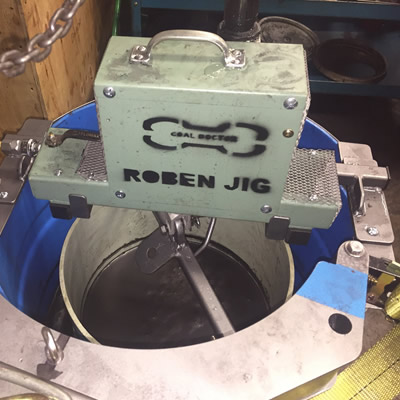Water-based coal sample cleaning technology could eliminate economic risk of coal exploration

The cylinder "jigs" coal samples and water to separate the samples based on density. — Photo courtesy Melanie Mackay Even though coal is one of Briti
The cylinder "jigs" coal samples and water to separate the samples based on density. — Photo courtesy Melanie Mackay
Even though coal is one of British Columbia’s largest exports, its exploration testing methodology is outdated, economically unreliable and harmful to those who handle the materials. Currently, a chemical-based process is used to clean metallurgical coal when determining its potential for coke. A new water-based method using a Roben Jig to clean metallurgical coal could replace the current process to provide a more accurate assessment of a coal project’s economic feasibility.
The Canadian Carbonization Research Association (CCRA) and Geoscience BC will begin a joint research effort of the Roben Jig. The goal is to find a reliable testing method and one that eliminates the use of harmful chemicals. The new methodology is positive for companies from both an economic standpoint and a health and safety perspective.
Melanie Mackay, president of the Western Canadian Coal Society and a technical member of the CCRA, said that this new technology will allow geologists to more accurately determine the coal’s quality and coking potential in exploration. The more accurate information gathered during exploration will help exploration teams appropriately evaluate their property.
The current process used to remove impurities from the exploration coal samples across Canada uses solvent-based, harmful liquids. One of these liquids is perchloroethylene (PCE), which was used in dry cleaning until the government banned its use. Because of this, another goal of this study is to find a replacement for PCE before the government bans its use in mining as well. Clearly, it is a harmful material. “I hope we can get rid of that use altogether,” Mackay said.
The CCRA has been looking at the effects of organic liquids on coking properties of coal for a few years. “The organic liquids that the industry uses right now—in some coals—they make the coal’s quality and characteristics look worse than they really are,” Mackay said. In other cases, they make it look better. The inconsistencies create economic risk in the industry. “We identified that as a risk we need to eliminate,” she said.
From a health and safety standpoint, the elimination of the regular use of harmful chemicals has been a long time coming. “Our long-term goal is to eliminate the use of those organic liquids,” said Mackay. “They are nasty and bad for your health.”
The current research project will “assess the effectiveness of an innovative water-based cleaning process for washing exploration samples of British Columbia metallurgical coal used in the steel-production process to determine coal and coke quality,” Mackay said. The results of the tests are key considerations in evaluating the economic feasibility of coal deposits.
The Roben Jig was created by Lindsay Bone. Coal is loaded into the cylinder with water. Coal particles are sorted with the heaviest particles landing at the bottom of the cylinder by a controlled “jigging” motion.
The CCRA was looking for a device to test small coal samples as a means to evaluate a deposit’s economic feasibility. “We’re looking at it to be sitting in a lab. It’s for small mass exploration samples,” said Mackay. Exploration-sized coal samples are five to 30 kilograms. The quality of the sorted and cleaned coal is tested for variables including maximum fluidity and coke strength after reaction.
If the Roben Jig consistently evaluates coal at a more accurate level than do the current methods, the next steps would include testing a larger variety of coal to understand the Roben Jig’s potential applications in Canadian coal mining. “After this phase, it will be basically honing down the methodology,” Mackay said.
Despite the lack of attention the exploration and testing process of coal deposit samples has seen until this point, the Roben Jig research project has received a welcome response. “It’s taken years for people in the coal industry in Canada to catch on that the organics affect the coal quality,” said Mackay. “Now that everyone is up to speed, they recognize that we need to get something working.”



